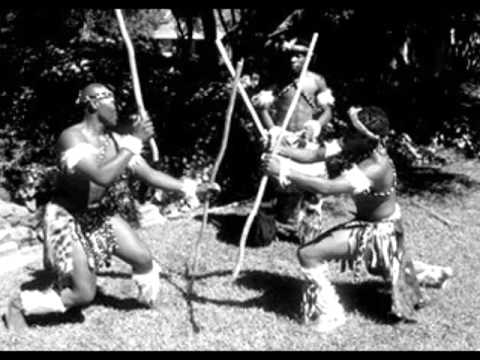READ ALSO: Gena Ethiopian Traditional Game
Zulu Traditional Games: Zulu Stick Fighting & the Isikhwili Stick
Zulu stick-fighting uses an isikhwili, or attacking stick, an ubhoko, or defending stick, and an ihawu, or defending shield.
The object is for two opposing warriors to fight each other to establish which of them is the strongest or the “Bull” (Inkunzi).
In modern times this usually occurs as part of a wedding ceremony, where warriors from the bridegroom’s household and area welcome warriors from the bride’s household and area to meet to “get to know each other”.
Other groups of warriors may also be welcome to join in.
Warriors do this by engaging in combat with one another. An induna, or war captain/referee, from each group of warriors keeps his crew in check and keeps order between fighters.
Table of Contents
Traditional Sports in South Africa #1: Nguni Stick Fighting/Intonga Stick Fighting/South African Stick Fighting
Nguni stick-fighting is a martial art traditionally practiced by teenage Nguni herdboys in South Africa.
Each combatant is armed with two long sticks, one of which is used for defense and the other for offense. Little armor is used.
Although Nguni/Xhosa styles of fighting may use only two sticks, variations of Bantu/Nguni stick-fighting throughout Southern Africa incorporate shields as part of the stick-fighting weaponry.
READ ALSO: Fun Ethiopian Games, 10 Traditional Sports in Ethiopia & More
Traditional Sports in Africa/Traditional Games in South Africa #2: Dibeke (Traditional South African Sports)
Next on this list of traditional sports in Africa is Dibeke.
Dibeke (also called Nikkies, Skaloulo and Kimberley Jim) is a multi-running ball game played with two teams of 12 players.
The teams take turns to attack and defend. Individual attackers are called and must kick the ball beyond the centre lines towards the attackers’ box. Watch a game of Dibeke in the video below.
READ ALSO: South African Sports: Intonga & Isinaphakade Samathongo
South African Traditional Sports #3. Boers Folk Wrestling
The Boers, or Afrikaners, are South African people of Dutch, Flemish, German and French (Huguenot) descent.
Usually the Boers folk wrestling matches along with other rustic sports (the Boeresport) like climbing the slippery pole, foot racing, sack race, leaping, three-legged race, running with an egg in the spoon, tug of war, arm wrestling, archery, spit sheep manure, stick fighting and etc. were played on the annually held festival called the Farmers’ Day (the Boeredag).
A 1902 newspaper article had this to say about Boers wrestling: “Amongst the young Boers wrestling is exceedingly popular.
The champion wrestler of a district is as much thought of as is his confrere in the North of England. Such a man can always have the pick of the prettiest girls in the district for a wife.”
Wrestling customs of the Boers were of Dutch/Flemish origin.
The wrestling styles (worstelen, wrestling, or werpen/gooien, throwing) of Dutch and Flemish people existed in two distinctive modes: the standing wrestling for a throw and the up and down wrestling for taking someone down and overcoming him on the ground/keeping him underneath.
Among the wrestling techniques used by the Dutch/Flemish farmers were aanklampen (catching holds) and vasthaken (hooking legs). Plukharen (grasping hair) as well as any other non-wrestling or deliberately brutal acts were strictly prohibited during the wrestling contests.
The folk wrestling styles of Boers were very popular in the 18th and 19th centuries, but they slowly became extinct after the introduction of traditional British wrestling styles to South Africa in the early 1900s.
Nowadays the international/Olympic styles of wrestling (namely Greco-Roman and freestyle) are the only wrestling styles practiced in South Africa.
READ ALSO: 7s Game Rules 2025 & More on the Fun Game Sevens
Traditional Sports in Africa – South Africa #4. Musangwe
Next on this list of traditional sports in Africa is Musangwe.
Musangwe is a bare knuckle annual boxing competition. Combatants range from 9 years old to 90 years old.
The fighters are split into different groups: Mambibi is for young boys 9-12. Next is Rovhasize or Rova for teenagers 13-18. These groups compete early in the morning until it gets later and it’s time for the groups of people to come to see.
The fighters aged 18 and over are called, “Ngwenya” or Crocodiles. Fighters aged 35-45 years are called the “Masters” and those over 45 are referred to as “Legends”.
Rivals are separated according to the side of the Lundevine River on which they reside.
Photo Credit: Face2Face Africa
